5 Books Every Leader Should Read

I was asked recently by a long time friend about the five best books on leadership that I’ve read. This friend, Sherry, donates a considerable amount of her time investing in the lives of young people. She’s mentoring people who will one day help shape their communities, who will someday govern our state and nation, and who are already making the world a better place for the rest of us. I’ve seen the results of her efforts and know first hand how effective and influential she is on the national stage.
As part of her latest leadership development venture, she is working with a small group of already established young leaders as they continue to broaden their leadership horizons. I was humbled that she’d ask for my input on the books I’ve found to be of value.
As I began thinking about my top five books, I turned to my list of Recommended Reading and Resources. This list includes books on becoming a better leader, on building a thriving business, on networking with your peers, and on developing other skills that will prove useful in the business world. I thought it would be easy to simply pick five from this list.
I was wrong.
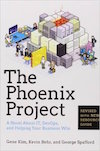 As I browsed through the books, I realized that many of them were written from a business perspective. For example, The Phoenix Project is an excellent book on leadership that I recommend to every IT leader that I work with in my consulting practice. However, the concepts and applicability may be lost on a 19-year-old without the experience of working in a rather dysfunctional IT shop, one where Murphy’s Law reigns and politics abound.
As I browsed through the books, I realized that many of them were written from a business perspective. For example, The Phoenix Project is an excellent book on leadership that I recommend to every IT leader that I work with in my consulting practice. However, the concepts and applicability may be lost on a 19-year-old without the experience of working in a rather dysfunctional IT shop, one where Murphy’s Law reigns and politics abound.
So as good as The Phoenix Project is, I culled it from my list of books I would recommend in my Top 5. Also gone were Dave Ramsey’s Entreleadershp and most of the books by Patrick Lencioni for similar reasons.
I looked for books that teach leadership principles without presupposing use in growing a business or managing a specific environment. I also considered books that, while not specific to leadership, would be helpful for developing leaders.
Top 5 Leadership Books
So, what are my Top 5 books I’d recommend to developing leaders? Five books that I think all leaders should read at some point in the careers, and the earlier, the better? I’ve compiled the list below. These books are listed in the order I’d suggest reading them, not because of their level of influence or degree of greatness, but rather, because of the order of the concepts presented.
Here are the concepts that influenced my selection:
- You must understand that truly great leaders are flexible in the ways they lead and serve their teams.
- To best serve your team, you must understand them and their preferences.
- You must acknowledge that you cannot do it all and that your team has a near limitless potential if you only unleash it.
- Adversity will come. It always does. But a good leader can shepherd his team through the difficult times.
- You must accept responsibility for every facet of your team and your role.
And now for the Top 5 List.
1. Leadership and the One Minute Manager
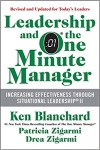 In his classic book Leadership and the One Minute Manager, Ken Blanchard debunks the concept of a one-size-fits-all approach to leadership. We know this intuitively. You would not lead a six-year-old the same way you would a 66-year-old. Yet for some reason, many people buy into the notion that they should adopt a single approach to leadership. In this short and easy to read allegory, Blanchard shows how we should adapt our leadership style to best serve those we are leading.
In his classic book Leadership and the One Minute Manager, Ken Blanchard debunks the concept of a one-size-fits-all approach to leadership. We know this intuitively. You would not lead a six-year-old the same way you would a 66-year-old. Yet for some reason, many people buy into the notion that they should adopt a single approach to leadership. In this short and easy to read allegory, Blanchard shows how we should adapt our leadership style to best serve those we are leading.
2. Taking Flight!
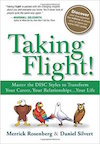 Have you ever completed a task that wasn’t on your To-Do List and then added it just so you could experience the satisfaction of checking it off the list? Or does that sound completely nuts to you? If you are a High D like me, you’ll know exactly what I’m talking about.
Have you ever completed a task that wasn’t on your To-Do List and then added it just so you could experience the satisfaction of checking it off the list? Or does that sound completely nuts to you? If you are a High D like me, you’ll know exactly what I’m talking about.
The DISC profile is a great, easy to use tool for quickly identifying your communication and behavioral preferences. With a little effort, you can begin to understand others’ preferences as well, and that will help you to better communicate and work with others. Sound dry and boring? It could be. But Merrick Rosenberg makes it interesting and easy to understand in Taking Flight!
In the short and simplified fable, a group of birds is challenged and must figure out how to respond. As you read, you learn that each species represents a different classification in the DISC model – Dominant, Influential, Steady, and Compliant. The birds must use their strengths to work together and overcome the challenge. In the second part of the book, the concepts are explained in detail.
Understanding the DISC profiles can help you to better communicate with your team, to offer constructive feedback in a more effective manner, and to delegate in a way that helps your direct reports to succeed.
3. Turn the Ship Around!
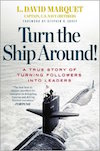 As leaders, we’ve been told that the buck stops with us, that we are responsible. Period. As a result, many attempt to control all aspects of their teams. They make all decisions. They become experts in every area. They micromanage everything, suppressing the voices and ideas from their teams and relegating them to a bunch of task-takers rather than leveraging their God-given abilities and harnessing their enthusiasm.
As leaders, we’ve been told that the buck stops with us, that we are responsible. Period. As a result, many attempt to control all aspects of their teams. They make all decisions. They become experts in every area. They micromanage everything, suppressing the voices and ideas from their teams and relegating them to a bunch of task-takers rather than leveraging their God-given abilities and harnessing their enthusiasm.
That’s what almost happened to USN Captain David Marquet when he was put in charge of his first submarine. But a last-minute surprise force him to adopt a new style of leadership, one that helped him to transform the worst submarine in the fleet into one of the best. In his book, Turn the Ship Around!, Captain Marquet recalls just how he did it. It’s an interesting and informative read.
4. Shackleton’s Way
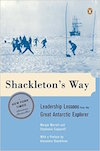 In 1914, Ernest Shackleton assembled a small crew of able-bodied seamen in hopes of becoming the first team to cross the barren and fridged landscape of Antarctica. His attempt, however, was thwarted when his ship, the Endurance, was trapped in the frozen waters of the Weddell Sea. As the ice crushed the ill-fated ship, Shackleton and his team were left floating aimlessly on a small sheet of ice on the harsh and unforgiving seas.
In 1914, Ernest Shackleton assembled a small crew of able-bodied seamen in hopes of becoming the first team to cross the barren and fridged landscape of Antarctica. His attempt, however, was thwarted when his ship, the Endurance, was trapped in the frozen waters of the Weddell Sea. As the ice crushed the ill-fated ship, Shackleton and his team were left floating aimlessly on a small sheet of ice on the harsh and unforgiving seas.
For over a year, Shackleton and his crew endured the hardships of being lost at sea and forgotten by those they left behind. Assumed dead, they faced overwhelming odds and were forced to make difficult decisions in an attempt to survive and effect their own rescue.
In a story every bit as spectacular and amazing as Apollo 13, Shackleton led his crew to safety without losing a single man. And what’s more, many of his crew wrote in their diaries during the trials “One of the best days of my life.”
In Shackleton’s Way, Margot Morrell thoroughly researched Sir Ernest Shackleton’s multi-year ordeal and has documented the principles that he used to lead his men to safety. Shackleton, who has been called “the greatest leader that ever came on God’s earth, bar none,” created a sense of camaraderie among his crew, managed strong personalities during difficult times, took calculated risks, and successfully led his team to safety during the most trying of times.
5. Extreme Ownership
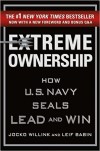 Navy SEALs are often thought to be high-octane adrenaline junkies with a reckless regard for people and structure. Jocko Willink and Lief Babin prove that this is seldom the case. In their book, Extreme Ownership, the duo share leadership lessons they learned on the battlefield and in the streets of some of the most dangerous places on earth.
Navy SEALs are often thought to be high-octane adrenaline junkies with a reckless regard for people and structure. Jocko Willink and Lief Babin prove that this is seldom the case. In their book, Extreme Ownership, the duo share leadership lessons they learned on the battlefield and in the streets of some of the most dangerous places on earth.
In each chapter, they share a story from the frontlines that illustrates an effective leadership principle in action. They tell of times when they had imperfect information and had to make a decision quickly of times when other units didn’t cooperatively participate in the planning and execution phases of a mission, and of times when the higher-ups seemed to micromanage their teams’ areas of responsibility. Then Willink and Babin explicitly describe the leadership principles involved and even tell how they have applied these principles in their post-service leadership consulting business.
“Oh, but, they were in the military so, of course, their teams had to comply. In the real world, it’s not like that,” you say? Willink and Babin answer that objection. When the stakes are high, even life-endangering, they tell, you must earn the respect of your team and communicate the “whys” of the mission. People will not risk their lives without believing in the men or women who lead them.
This book is one of the best books on personal responsibility and leadership that I’ve read. If you only read one of these books, this is the one you should select.
Conclusion
It’s been said that the most successful people learn constantly and read voraciously. I’d have to agree with that and I’d encourage anyone who is charged with leading in any capacity to read these books.
But, these books only represent a start; they are the first steps of a journey. Simon Sinek’s Start with Why, for example, is a great book that could have easily been added to this list. So is It’s Your Ship by Capt. Michael Abrashoff. I’m sure there are many more.
Have a book that has really influenced your life or career? I’d love to hear about it. I’m always looking for my next good read.

2 Responses
A new college grad thirty years ago, I read Tom Peters book In Search of Excellence, and started attending those community events where you could watch him “live.” Stories of how Nordstrom replicated and scaled “mom and pop shop” customer service into a large corporate setting, making it a core to their brand, is seared in my mind, and helped me tremendously in my career. Over three decades, owning three public relations firms, I always remembered the importance of modeling the behavior you wanted from your team. Peters’ work was seminal in this regard.
In Search of Execellence is a great book! And I completely agree, modeling the behavior we wish to encourage is critical.